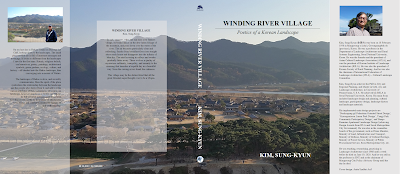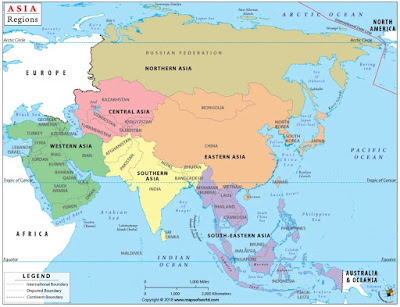Winding River Village by Kim, Sung-Kyun
As what Prof. Kim, Sung-Kyun said in opening of his conclusion of this book:
“The
purpose of my study has been the interpretations of variety and distinct
landscapes with reference the meanings inherently imbedded, culturally
perceived, traditionally exposed, spatial manifested and also poetically
symbolized. This is not a problem with a solution or a final proof. There are
no conclusions nor do the meanings add up to any single conclusion. Of course,
it would be in vain, and maybe wrong-headed, to present and summarize all the
different meanings of Hahoe landscapes that I found. Studying the meanings of
landscapes involves refining and constantly expanding one’s understanding. The
meaning of the landscape of Hahoe is still open to all of us and also to the
resident villagers to interpret and re-interpret. Nevertheless, we need further
refinements to understand their landscapes. Let me end their stories of the
landscapes at this destination. I have been “There” and now I am “Here,” and
sometimes “here”-and-”there” both at once, I think it is time to tell my story
of intimate attachment - “Being Here.” Also, finally becoming part of the life
world, through mutual cohesiveness and awakening my own feelings.”
I can
dive to the deepest abyss of Prof. Kim, Sung-Kyun's feelings, to understand how
holy and sacred his love to the Korean Landscape Garden as his own identity.
His love to not only Korea national identity, but also his strong nationalism,
and universal humanism on this Earth.
Although
the word "Nujeongwon" is not mentioned in the "Winding River
Village" book, the spirit of this book is Nujeongwon. I realized this
after analyzing each chapter, especially chapter six, namely THE SIXTEEN
BEAUTIFUL LANDSCAPES. This awareness was strengthened, stronger and stronger
after I analyzed some of his lecture materials with very similar content. The
lectures I meant, among others: “A Sustainable Korean Traditional Landscape
Garden 'Nujeongwon'” (Korea, December 2010; Estonia, November 2011; Korea,
December 2011), “Meaning and Aesthetics of a Korean Traditional Landscape:
Focusing on Hahoe Gyeomam-Okyeonjeong” (documented in the Proceedings of 2013
ACLA International Symposium. 12 ~ 14 October 2013 in Seoul, Korea, on pages
39-46), “Way of Seeing In Traditional Korean Landscape Garden” (Korea, 19
October 2014), “Poetics of a Korean Cultural Landscape” (11 October 2018, Bali,
Indonesia), and at the eighth ACLA meeting, “Perception, Aesthetics and and
Sustainability of Korean Cultural Landscape” (Johor, Malaysia, 9 October 2019).
And
then, through the synthesis process of all existing materials, I discovered the
mystery, that this Winding River Village book is the womb from which the proper
term for Korean landscape garden, “Nujeongwon” was born.
Different
from the Western terminology that applies in almost all parts of the world, “a
traditional Korean landscape garden, 樓亭苑
(Nujeongwon) is an exterior space, organized visually and conceptually as a
whole, centered around nujeong building.” This definition was thought deeply
and declared firstly by Prof. Kim Sung-Kyun, to distinguish traditional Korean
gardens from Western concepts of gardens, and because he cannot explain a
Nujeongwon in terms of the Western concept of a garden.
After
conducting research on Korean Nujeong and Nujeong-gi in 2007 under the auspices
of the Kyujanggak Institute for Korean Studies, Prof. Sung-Kyun Kim found that
there are more than 3,000 nujeongwons spread around South Korea now. The nujeongwons have sustained for more than
1,000 years in Korea.
Honestly,
based on my deep reflection after reading this Winding River Village book many
times, it would not be an exaggeration to place this book on the same level as
the scriptures. it's all about the principles to sustain human life and all
other creatures, the harmonious relationship between humans and the natural surroundings
on this Earth.
In good
and true faith, I have taken the initiative to continue Prof. Sung-Kyun Kim and
ACLA’s mission. It is to realize the vision of sustainable life on Earth for
all humans and other species, with a cultural and ecological landscape
approach.
One of
these efforts is by republishing his main book, from PhD dissertation of Prof.
Sung-Kyun Kim, which was published by ACLA Publisher, in South Korea, in 2016.
Because organizationally, ACLA was discontinued, so ACLA Publisher could no
longer function. So, as the ACLA secretary (2015 ~ 2020) and the lover of the
vision and mission of Prof. Sung-Kyun Kim, I act with full awareness as the
publishing initiator of Winding River Village book, especially in form of
e-book, so it can be available globally.
The book was just republished yesterday, with
ISBN
978-623-5609-78-2
(e-book)
978-623-5609-77-5
(p-book)
This WRV book is the womb from which Nujeongwon book was born. Nujeongwon in turn plays a role in maintaining the context of the ecological design of landscapes on this Earth.
Anita
Syafitri Arif
ACLA~APELA
Secretary (2015~2020)
The
Author of
“Nujeongwon dan Kelestarian
Ekologis, Pelajaran Penting dari Prof. Sung-Kyun Kim” book.
Bali,
Januari 2022




Comments
Post a Comment